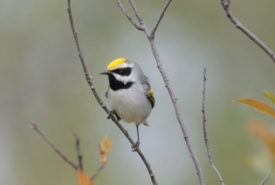
Golden-winged warbler (Photo by Christian Artuso)
Golden-winged warbler
A group of organizations, including Bird Studies Canada, Environment Canada, Parks Canada and the Nature Conservancy of Canada (NCC), is hoping to find out as much as it can about the golden-winged warbler in Manitoba. Members of the Northwest Golden-winged Warbler Working Group are taking a close look at the threatened species. They're studying its population, nest success, habitat preferences, genetics and travel corridor requirements.
But golden-winged warblers aren't only threatened by habitat loss and fragmentation. According to Christian Artuso of Bird Studies Canada, the biggest problem appears to be genetic swamping by their closely related sister-species, the blue-winged warbler. Due to human influence, in particular land clearing that has removed habitat barriers and created more of their preferred habitat, blue-winged warblers have been expanding into the range of the golden-winged warbler. They out-compete and interbreeding with golden-winged warbler.
This is the case at Ontario's Carden Alvar. "Most of the golden-winged warblers have been replaced with hybrids and pure blue-winged warblers," says Dan Kraus, NCC's conservation scientist. "This is pretty typical of what has happened throughout much of the range when these two species overlap. Golden-winged warblers are eventually replaced by blue-winged warblers." Kraus adds that both species appear to be expanding their ranges. However, blue-winged warblers are expanding faster than golden-winged warblers. "These species are obviously very closely related," comments Kraus. "For some reason, blue-winged warblers seem to eventually dominate over golden-winged warblers."
"When blue-winged warblers move into a new area, golden-wings typically disappear within about 50 years," says Artuso. "Manitoba is basically the only area of the golden-winged warbler's breeding range where there are no blue-winged warblers," he adds. Genetic testing suggests that western Manitoba is the only area left with pure golden-winged warblers.
There is therefore a lot of interest in studying the Manitoba population to learn as much as possible about what "pure" golden-wings need to survive. The hope is that this knowledge can be applied to conservation, says Artuso.
"Manitoba may be this species' last chance at survival," says Cary Hamel, conservation science manager in NCC's Manitoba Region. The research and support programs that NCC, the working group and volunteers are conducting will go a long way towards better understanding the golden-winged warbler. Hopefully one day this bright bird will be a common sight once more.





